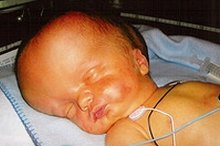Signs & Symptoms of Fluid on the Brain
Hydrocephalus, also referred to as "fluid" or "water on the brain", is a condition where too much cerebrospinal fluid has built up in the skull. The increase of spinal fluid takes up space in the skull and puts pressure on the brain causing symptoms that manifest in different ways depending on the age of the victim. Normally, spinal fluid surrounds and cushions the brain and spinal cord delivering nutrients and compensates for pressure changes due to the blood volume in the brain.
Causes
Hydrocephalus occurs when a condition obstructs the normal flow or blocks the absorption of the fluid. Hydrocephalus can affect newborns. In newborns it is also called congenital hydrocephalus, which is due to premature birth, abnormal fetal development or an inherited genetic trait. Acquired hydrocephalus can occur as a result of disease, like meningitis or injury.
Types of this condition that normally affect adults are hydrocephalus ex-vacuo and normal pressure hydrocephalus. Hydrocephalus ex-vacuo happens after a stroke or injury damages the brain. Normal pressure hydrocephalus may not have a cause, but can result from head trauma, infection, tumors, subarachnoid hemorrhage or complications of surgery.
Infant Symptoms
How to Determine Hydrocephalus Life Expectancy
Learn More
Symptoms of hydrocephalus in infants are different than older children or adults because the joints that connect the bones of the skull haven't closed which allows more flexibility in the skull. Signs of hydrocephalus in an infant include a rapid increase in head size, vomiting, sleepiness, irritability, seizures and the "sunsetting" sign in which the eyes appear to look downward with the white part of the eye more visible than the colored or dark parts of the eye.
Older Child or Adult Symptoms
Symptoms of hydrocephalus in adults and children may present as nausea, vomiting preceded by a headache, double or blurred vision, "sunsetting" sign, unsteady balance, problems with coordination, difficulty walking, urinary incontinence, drowsiness, lethargy, changes in personality or the capability to think, reason and remember.
Normal Pressure Hydrocephalus Symptoms
What Are Water Head Babies?
Learn More
Symptoms of normal pressure hydrocephalus may mimic other conditions such as Parkinson's disease, Alzheimer's disease and Creutzfeldt-Jakob disease. Signs and symptoms of this type of hydrocephalus can include progressive mental impairment and dementia, problems with walking and dysfunction of bladder control. People with normal pressure hydrocephalus may complain of slow body movements.
Diagnosis and Treatment
Your physician will diagnose hydrocephalus based on a neurological exam that tests the brain, spinal cord and nerve function. Your physician may also order imaging tests to check for abnormalities in the structure of your brain. Not all tests will be indicated for every person.
Treatment involves the insertion of a shunt system or a third ventriculostomy. A shunt, which is generally the first line of treatment, is a flexible tube that reroutes the cerebrospinal fluid to another part of the body for absorption. A third ventriculostomy is an alternative procedure indicated for people over six months of age, those who have attempted treatment with a shunt and people with a certain type of hydrocephalus in which an obstruction is blocking the flow of cerebrospinal fluid.
Related Articles
References
Resources
Writer Bio
Since 2008, Jennifer S. Wright has written articles on a variety of topics including parenting concerns, medical conditions and nursing issues. Her articles have appeared in "LPN" magazine as well as on various online publications. An LVN since graduating from Weatherford College in 2005, Wright has taken care of elderly, pediatric and obstetric patients in hospital and home health care settings.








